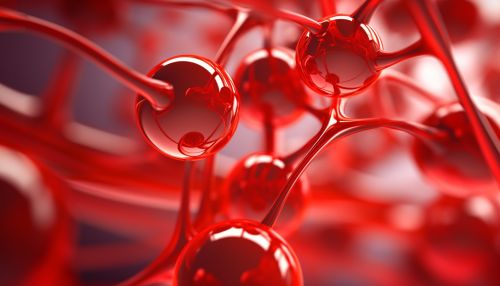Hemoglobin
Overview
Hemoglobin is a protein molecule in red blood cells that carries oxygen from the lungs to the body's tissues and returns carbon dioxide from the tissues back to the lungs. Hemoglobin is made up of four protein molecules (globulin chains) that are connected together. Its structure is a tetramer consisting of two alpha and two beta chains, each of which is bound to a heme group. Each heme group contains one iron atom, that can bind one oxygen molecule.


Structure
The structure of hemoglobin is complex, with each molecule consisting of four polypeptide chains, two of which are identical alpha chains and two identical beta chains. Each chain is attached to a heme group, a ring-like structure that contains an iron atom. The iron atom is the site of oxygen binding, allowing each hemoglobin molecule to bind up to four oxygen molecules. The structure of hemoglobin allows it to change shape, or "flip," as it binds and releases oxygen, which is key to its function.
Function
The primary function of hemoglobin is to transport oxygen from the lungs to the tissues of the body, where it is used for cellular respiration. Hemoglobin also helps in the transport of carbon dioxide and hydrogen ions back to the lungs. In the lungs, carbon dioxide is exhaled and the hydrogen ions combine with oxygen to form water. Hemoglobin also plays a role in maintaining the shape of the red blood cells. In their natural shape, red blood cells are round with narrow centers resembling a donut without a hole in the middle. Abnormal hemoglobin structure can disrupt the shape of red blood cells and impede their function and flow through blood vessels.
Hemoglobin Variants and Disorders
There are several genetic variations that can affect the structure and function of hemoglobin. These variants can lead to diseases such as sickle cell anemia, thalassemia, and various forms of hemoglobinopathy. In these disorders, the shape and functionality of the red blood cells are affected, leading to a variety of symptoms including anemia, fatigue, and increased susceptibility to infections.
Measurement and Diagnostic Use
Hemoglobin levels in the blood can be measured in a laboratory. The hemoglobin level is expressed as the amount of hemoglobin in grams (g) per deciliter (dL) of whole blood, a deciliter being 100 milliliters. The normal ranges for hemoglobin depend on the age and, beginning in adolescence, the sex of the individual. The normal ranges are:
- Newborns: 17 to 22 g/dL - One (1) week of age: 15 to 20 g/dL - One (1) month of age: 11 to 15g/dL - Children: 11 to 13 g/dL - Adult males: 14 to 18 g/dL - Adult women: 12 to 16 g/dL - Men after middle age: 12.4 to 14.9 g/dL - Women after middle age: 11.7 to 13.8 g/dL
Hemoglobin levels can be used to diagnose and monitor diseases and conditions that affect red blood cells, including anemia and polycythemia vera.
